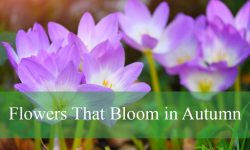Are you looking to purchase some outdoor palm plants? No need to search any further! You can pick the ideal palm for your patio, backyard, or balcony thanks to the extensive list I’ve put together.
Larger types of palms also offer essential shade. Palms are known for their capacity to instantly generate a tropical ambiance in outdoor settings. As long as they are appropriate for your particular USDA hardiness zone, many palms are remarkably low-maintenance despite their exotic look.
Typically thriving in zones above nine, these plants can tolerate varying conditions, including some that endure colder climates admirably.
Whether you’re seeking a majestic Areca Palm for its graceful fronds or a robust Windmill Palm for its hardy nature, this list covers a diverse array of options. Remember to bookmark your favorites from this extensive collection—you’re sure to discover the perfect palm to enhance your outdoor living space!
Different Types of Outdoor Palm Plants
Royal Palm
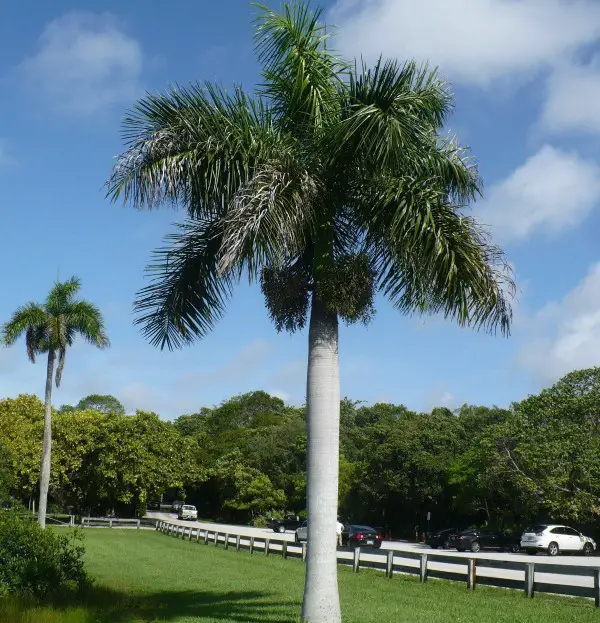
The Royal Palm (Roystonea regia) boasts a tall, sturdy, greyish-silver trunk with a crown of graceful dark-green leaves. Native to Florida, Mexico, the Bahamas, Belize, Cuba, the Cayman Islands, and Honduras, it thrives in USDA zones 10A and 10B. Preferring full sun and fertile, well-drained soil, it needs average watering.
Suitable for potting in a 10-inch pot, this palm’s seeds produce oil, its wood is used in construction, and its leaves are used for thatching. It can tolerate colds down to 28°F.
Paurotis Palm
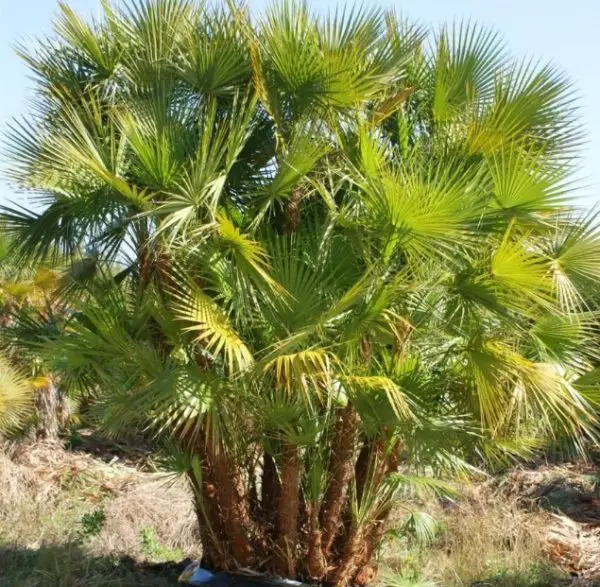
The Paurotis Palm (Acoelorrhaphe wrightii) features striking fan-shaped leaves, light green on the front and grey-silver on the back, with thorny leaf stalks. Native to South Florida, Mexico, Central America, and the West Indies, it thrives in USDA zones 9B-11, preferring full sun and loamy, well-drained soil.
It requires average watering and pruning. Suitable for pots, start with a 15-20 inch diameter, 10 inch deep pot, and consider repotting for continued growth. This palm tolerates temperatures down to about 25°F and moderate salt environments.
Areca Palm
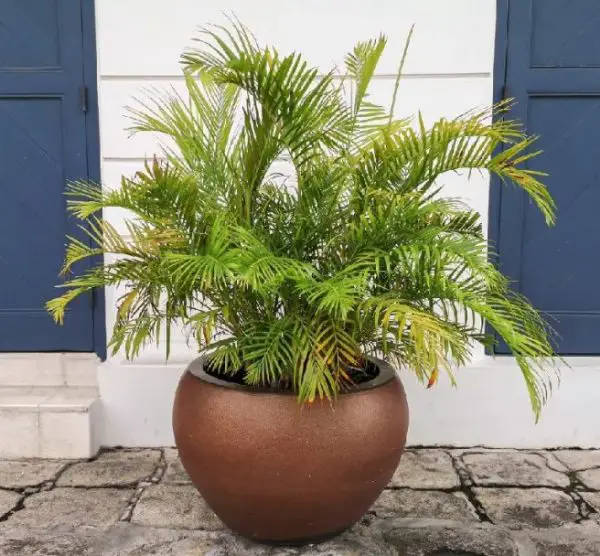
The Areca Palm (Dypsis lutescens), also known as the butterfly palm, showcases leaves that spread like butterfly wings. With a compact trunk, it features dark green to yellowish-green leaves. Native to Madagascar and thriving in USDA zones 10-11, it prefers bright sunlight and slightly acidic, well-drained soil.
Suitable for pots, it enhances both indoor and outdoor spaces, serving as a natural air purifier. This palm requires temperatures between 65°F to 75°F (18°C – 24°C) and cannot tolerate cold drafts.
Bamboo Palm
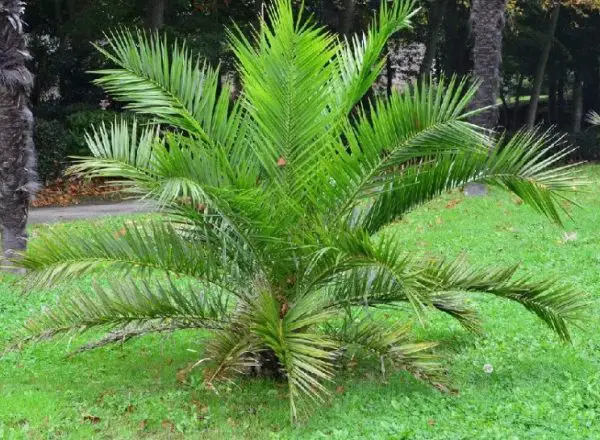
The Bamboo Palm (Chamaedorea seifrizii) grows in clusters with multi-trunks and dark greenish fronds. Native to Central America and suited for USDA zones 10-11, it thrives in partial shade with well-drained soil. Regular watering and fertilization promote healthy growth, and it’s ideal for pots that need repotting into larger containers upon purchase.
This palm serves as an excellent indoor air purifier and enhances indoor spaces, balconies, or verandas. However, it requires careful watering and a humid environment while being susceptible to pests and diseases.
European Fan Palm
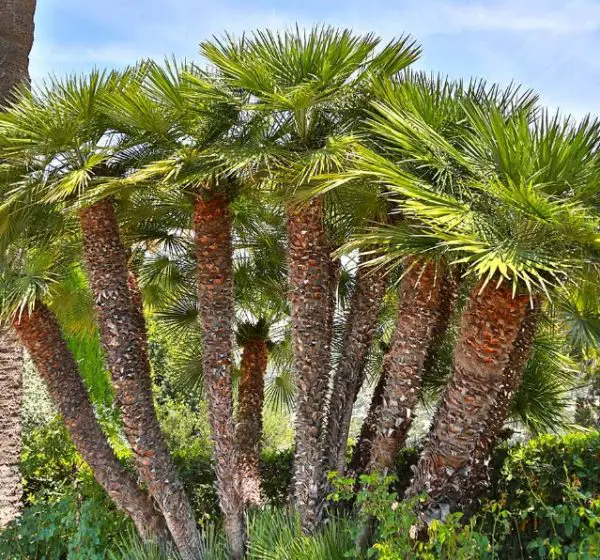
The European Fan Palm (Chamaerops humilis) is a shrub-like small tree with multiple stems originating from a single base and greenish-silver fan-shaped leaves. Native to Europe and thriving in USDA zones 8-11, it prefers full sun but adapts to low-light conditions. It thrives in rich, moist, well-drained soil with regular watering and seasonal fertilization.
Suitable for pots, it grows slowly to about 4 feet tall and 3 feet wide. This palm enhances spaces, produces edible fruit, and tolerates drought, salty conditions, and temperatures down to -12°C (10°F).
Pindo Palm
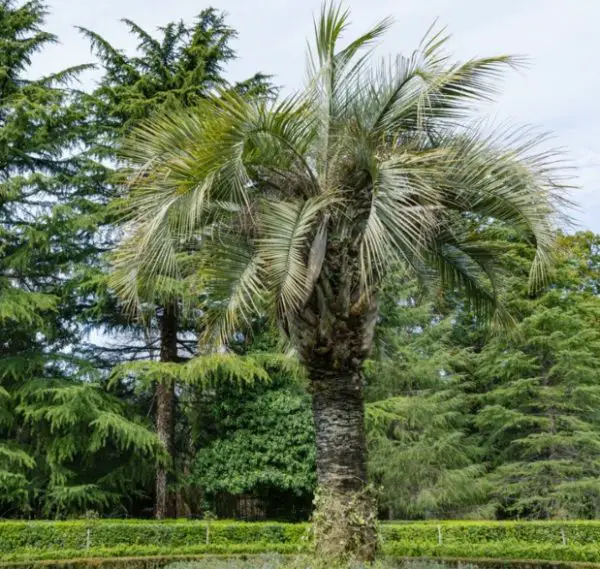
The Pindo Palm (Butia capitata) features a strong, sturdy trunk with greenish to greyish leaves gracefully arched towards the trunk, each divided into numerous pairs of leaflets. Native to Southern Brazil, Paraguay, Uruguay, and Argentina, it thrives in USDA zones 9-11, enjoying full sun and partial shade in loamy, sandy, well-drained soil.
Slow-growing in pots, it requires regular watering without waterlogging. Known for its edible fruits used in jams and wines, this palm enhances landscapes and indoor settings, withstanding temperatures down to -10°C (14°F).
Sentry Palm
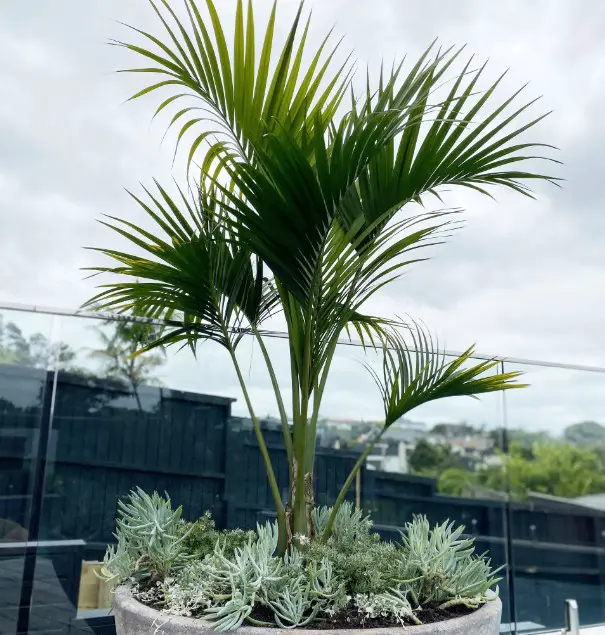
The Sentry Palm (Howea belmoreana), also known as the curly palm, features feather-like green fronds arching towards the trunk. Native to Lord Howe Island, Australia, it thrives in USDA zones 9-11, preferring partial sun and acidic, well-drained soil. With average water and regular fertilization needs, it’s suitable for pots due to its slow growth.
This palm acts as an excellent air purifier and enhances both outdoor and indoor spaces. It tolerates temperatures down to 55°F but dislikes frequent repotting, requiring careful root management.
Pygmy Date Palm
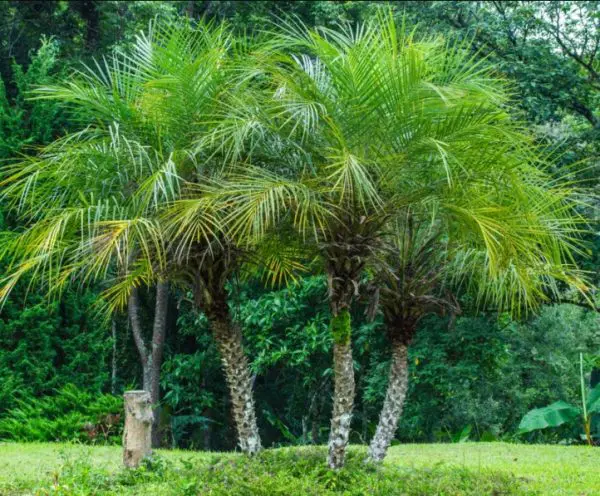
The Pygmy Date Palm (Phoenix roebelenii) features a single, sturdy trunk and heartwarming green fronds with delicate leaflets that arch towards the trunk, creating an eye-catching appearance. Native to subtropical areas of Southeastern Asia, it thrives in USDA zones 9b-11, preferring full to partial sun and loamy, well-drained soil.
With average water needs, it’s suitable for pots due to its slow growth, reaching up to 10 feet in height. This palm purifies air, enhances both indoor and outdoor aesthetics, and produces edible fruits. It withstands temperatures down to 26°F (-3°C).
California Fan Palm
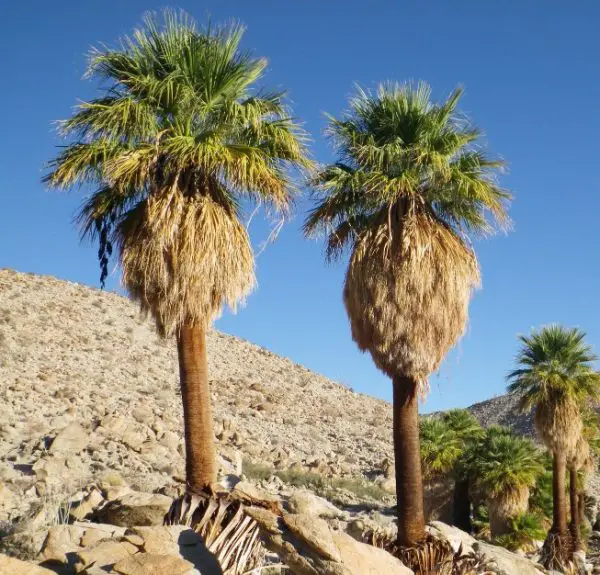
The California Fan Palm (Washingtonia filifera) is a majestic tree palm with a strong, sturdy trunk and greyish-green fan-shaped fronds. Unique to this palm is its dead fronds, which fold down along the trunk rather than falling off, enhancing its aesthetic appeal. Native to the Western U.S., it thrives in USDA zones 8-11, preferring full sun and loamy, well-drained soil.
Drought-tolerant with no pruning needs, it can be potted initially but thrives best when planted in the ground. This palm produces edible dates, and its leaves are used in various crafts like shoemaking and thatching roofs. It grows up to 50-60 feet tall and can withstand temperatures down to -5°C (23°F) briefly.
Sylvester Date Palm
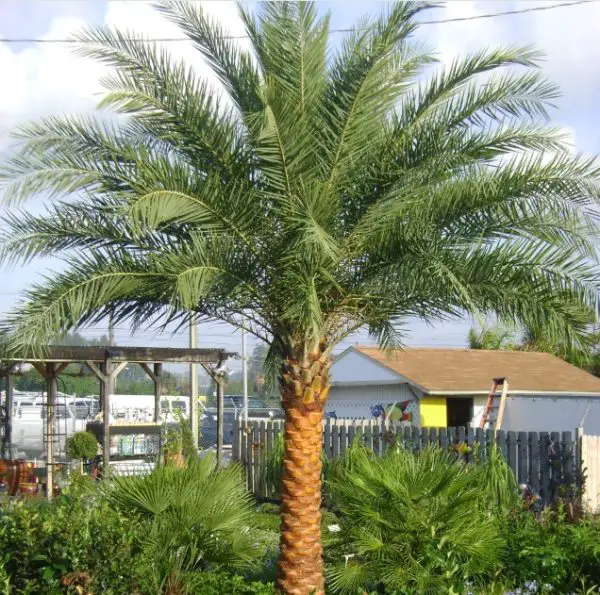
The Sylvester Date Palm (Phoenix sylvestris) features an elegantly patterned trunk and a crown adorned with classic fan-shaped palm fronds. Native to India and southern parts of Pakistan, it thrives in USDA zones 8b-11, preferring full sun to partial shade and fertile, well-drained soil with average watering needs.
While suitable for large containers temporarily, it’s a fast-growing tree that thrives best when planted in the ground. This palm produces delicious edible fruit used in various culinary delights, and the sap is fermented into a traditional drink called “toddy” in India. It can withstand temperatures down to 15°F for short periods.
Miniature Chusan Palm
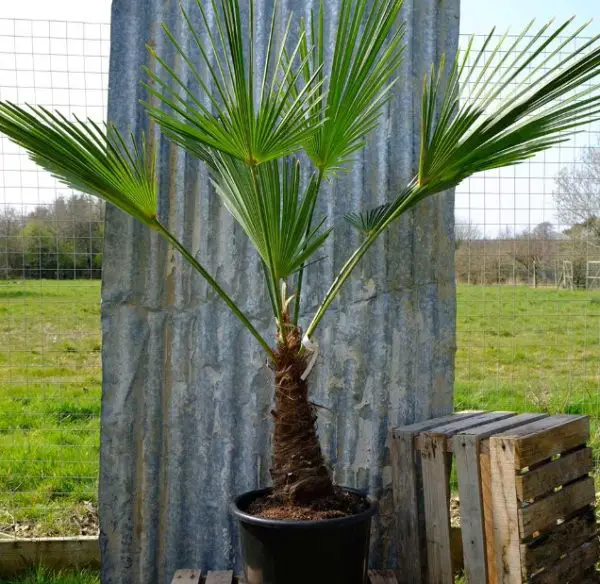
The Miniature Chusan Palm (Trachycarpus wagnerianus) features a trunk covered in brownish fibers and slender stems with fan-shaped leaves divided into segments. Native to central and eastern China, it thrives in USDA zones 8a-10b, preferring partial shade in dry, hot regions and fertile, well-drained soil.
With average watering needs and twice-yearly fertilization, it’s ideal for large pots initially due to slow growth. Ultimately, it should be planted in the ground to reach its full height potential of 25-30 feet tall and 5-8 feet wide. This palm is prized for landscapes and indoor settings, boasting wind tolerance as well.
Triangle Palm
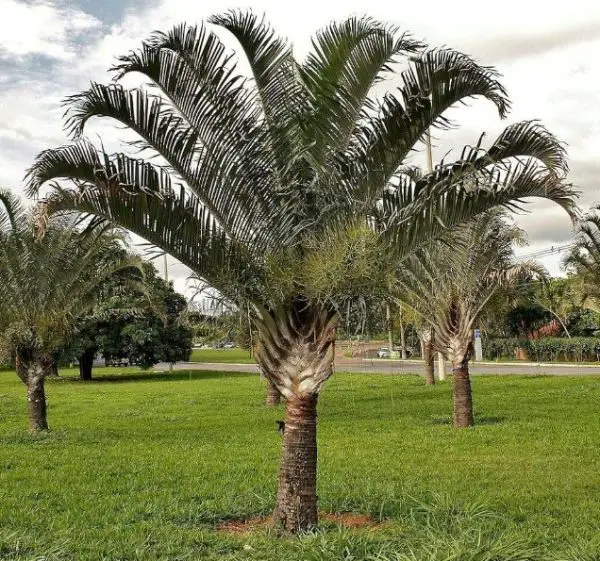
The Triangle Palm (Dypsis decaryi) is a stunning palm tree listed as vulnerable. It features a sturdy trunk and a crown of arched, greenish-blue to greyish-greenish pinnate leaves. Its name derives from the triangular shape on the trunk where fronds emerge. Native to the Madagascar rainforest, it thrives in USDA zones 10-13, preferring full sun and sandy, well-drained soil.
With average to low water needs and minimal pruning requirements, it can be potted with proper care. This palm enhances any space, and its fronds are used for roof thatching. Interestingly, it’s endangered in its native habitat, with only around 1000 individuals remaining, showcasing its importance in conservation efforts.
Florida Silver Palm
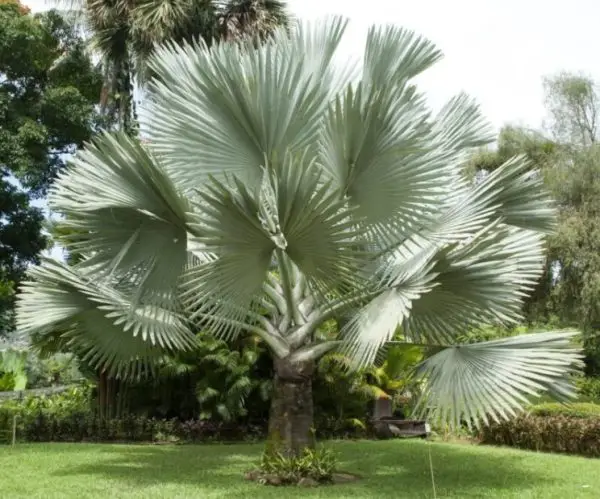
The Florida Silver Palm (Coccothrinax argentata) features a smooth, sturdy trunk topped with silvery green, fan-shaped leaves. It blooms creamy white, fragrant flowers that transition to purplish-black fruit by early fall. Native to South Florida, Mexico, Colombia, and the West Indies, it thrives in USDA zones 10-11 with preferences for full sun and sandy, well-drained soil.
With average water needs and rare pruning requirements, it adapts well to being potted indoors, growing approximately 6 inches per year. This palm enriches gardens, balconies, and verandas while providing food for birds and insects. Notably, it withstands drought and salty winds effectively.
Key Thatch Palm
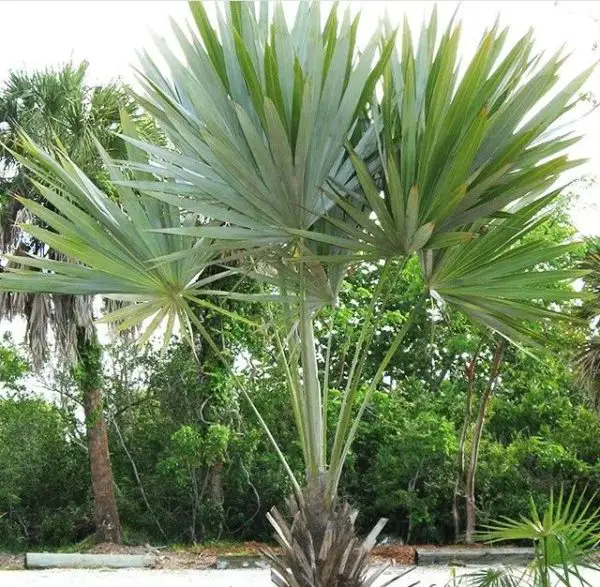
The Key Thatch Palm (Leucothrinax morrisii) boasts a strong, smooth trunk and a crown adorned with fan-shaped fronds, dark green from above and blueish-grey underneath. In spring, it blooms with whitish flowers. Native to regions including the Florida Keys, Bahamas, Cuba, and Haiti, it thrives in USDA zones 10-11, preferring full sun to partial shade and fertile, well-drained soil.
While it can start in pots, it thrives best when transplanted into the ground due to its slow growth. This endangered species is drought-tolerant, salt-tolerant, and can endure brief freezing temperatures.
Parlor Palm
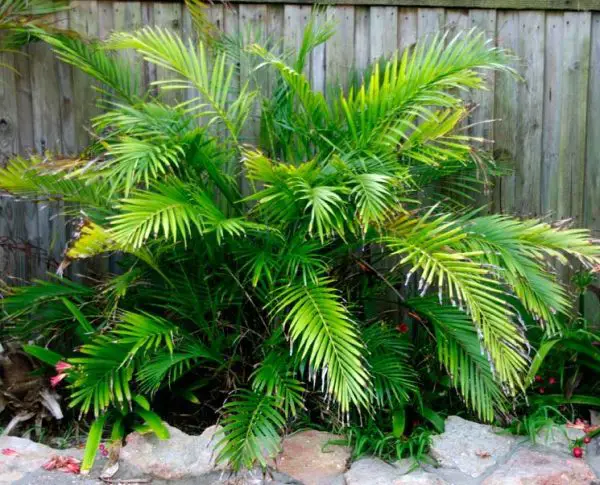
The Parlor Palm (Chamaedorea elegans) features majestic deep to light green fronds and bright green arching stems. Native to the rainforests of southeastern Mexico and northern Guatemala, it thrives in USDA zones 10-12, preferring partial to full shade and indirect bright light indoors. It requires rich, well-drained soil and moderate watering to thrive.
Ideal for indoor containers, it grows 3-6 ft tall and 2-3 ft wide. This popular indoor plant purifies air effectively and enhances oxygen levels, contributing gracefully to indoor spaces.
Jelly Palm
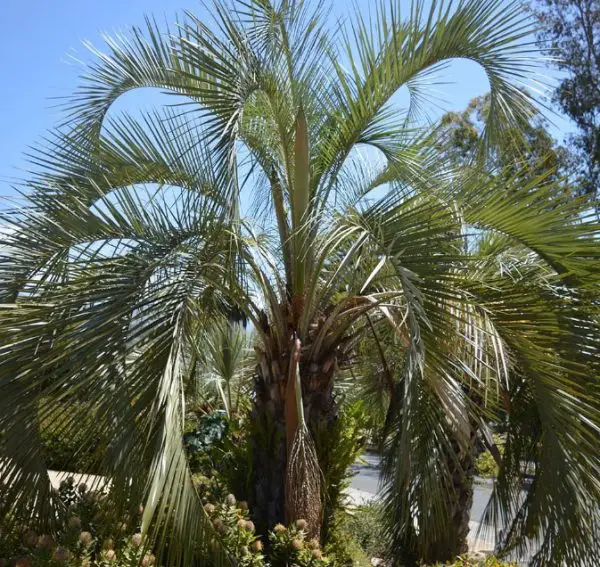
The Jelly Palm is a graceful tree with a sturdy trunk and feathery, arching leaves in bluish-green to grayish-green hues. Native to Uruguay, Brazil, and Argentina, it thrives in USDA zones 9-11, enjoying partial shade to full sun and well-drained clay or sandy soil.
With average water needs to avoid root rot, it produces sweet, edible yellowish-orange fruit in late summer. It’s adaptable to pots but achieves its maximum height when planted in the ground, enhancing landscapes and offering medicinal uses for eye and skin ailments.
Majestic Palm
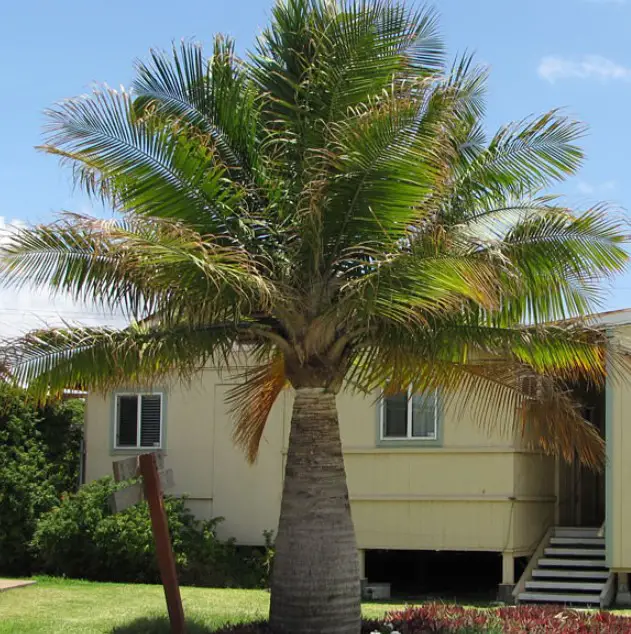
The Majestic Palm, native to Madagascar, features olive-greenish, feathery fronds originating from a swollen base. Thriving in USDA zones 10-11, it prefers partial shade or bright indoor spots, with fertile, well-drained soil and regular watering to keep moist. Adaptable to pots due to slow growth (up to 1 ft per year), it enhances indoor air quality by removing toxins. In its natural habitat, it can reach 80 ft, while indoors it grows slower, maxing out at 8-10 ft.
Lipstick Palm
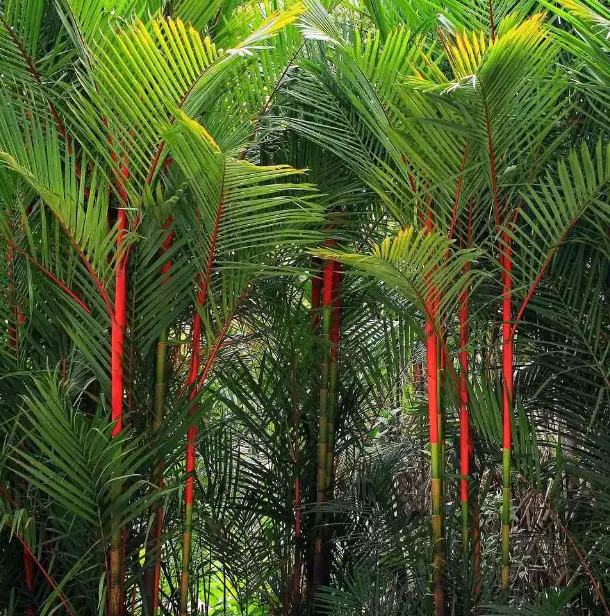
The Lipstick Palm, also known as the red sealing wax palm, stands out with its vivid red trunk and crown shaft, complemented by dark greenish pinnate leaves. Found in the rainforests of Malaysia, Indonesia, Borneo, and Southern Thailand, it thrives in USDA zones 10b-11, requiring loamy, fertile, well-drained soil and regular watering to keep it moist. It can be potted in a deep, wide container and reaches up to 35 ft tall. It enhances landscapes with its beauty and purifies the air, thriving in temperatures between 24-29°C (75-85°F).
Kentia Palm
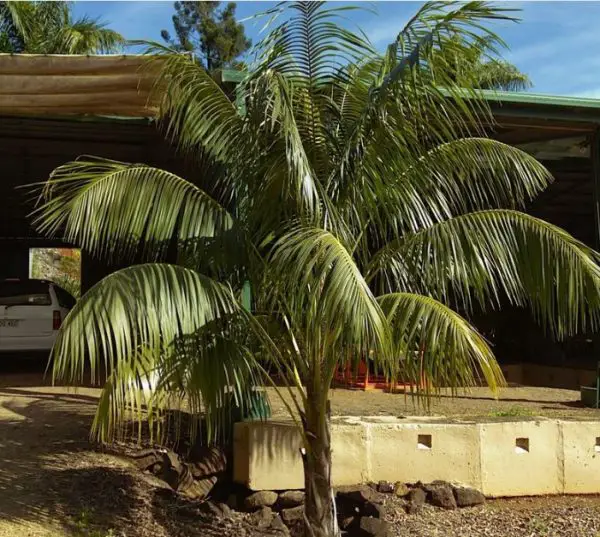
The Kentia Palm, native to Lord Howe’s Island, features palm-shaped fronds arching towards the trunk with dark green leaflets typically 10 – 18 inches long. Thriving in USDA zones 9-11, it prefers partial shade or indirect bright light to prevent damage from excessive heat or light. It requires fertile, sandy, well-drained soil and moderate watering to keep it slightly moist. Slow-release fertilizer annually supports growth. Common as an indoor plant, it purifies indoor air and grows up to 12 ft tall in pots.
Chestnut Dioon
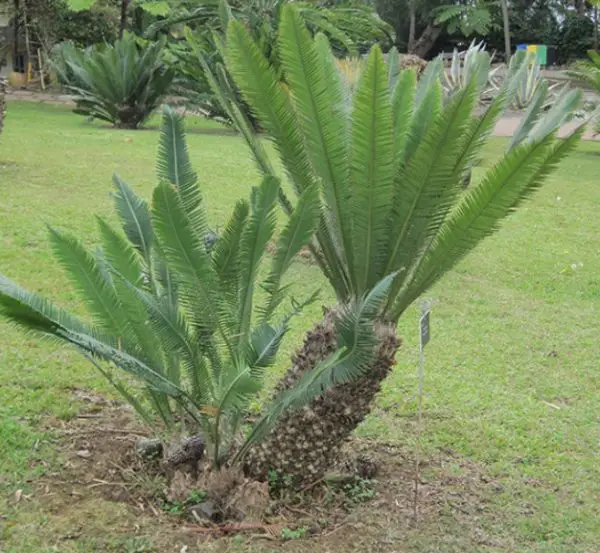
The Chestnut Dioon, native to Mexico, features a short, thick trunk and long, feather-like pinnate leaves with 100-160 narrow greenish-blue leaflets. Cones appear on both male and female plants. Thriving in USDA zones 9-11, it prefers full sun to partial shade and sandy, fertile, well-drained soil with average water needs.
Slow-growing, it can reach up to 8 ft tall in pots. Its seeds are edible when cooked, and the stem is a source of Mexican arrowroot. Known for its longevity, it can live up to a thousand years, tolerating extreme temperatures and harsh conditions like drought and salinity.
Windmill Palm
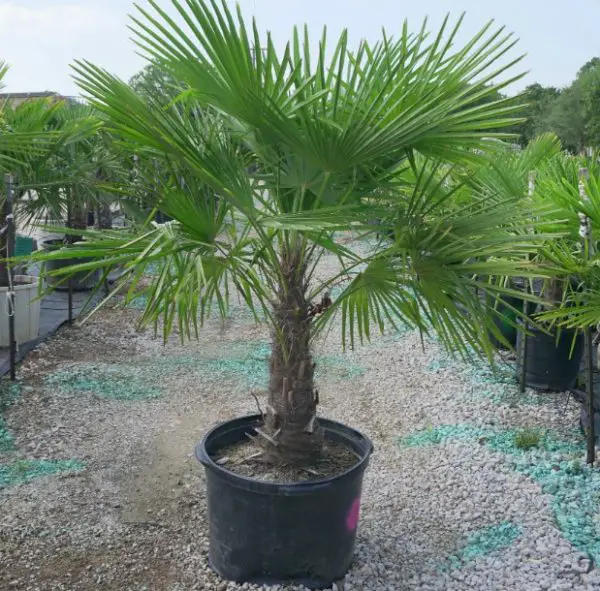
The Windmill Palm (Trachycarpus fortunei) has fan-shaped leaves and long slender trunks covered with brownish fibers. Native to China’s mountain forests, it thrives in USDA zones 8a-11, requiring partial shade and well-drained soil. Adaptable for potting, it grows 7-8 inches annually in containers. Its fibers are useful for making accessories, while its leaves can thatch roofs. Drought-tolerant and non-toxic to pets, it withstands brief cold spells down to -15°C.
Silver Saw Palmetto
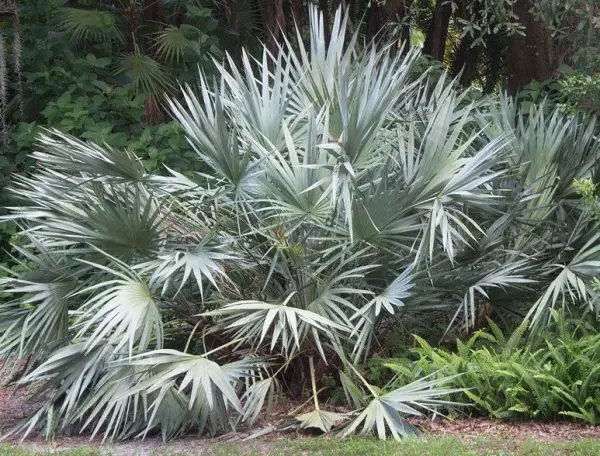
The Silver Saw Palmetto (Serenoa repens) features silver-green fan-shaped leaves with sharp teeth on stems. Native to Florida and the Southeastern U.S., it thrives in USDA zones 7-11, preferring sunny, dry, sandy soil. This slow-growing palm is suitable for pots, needing minimal water and no pruning. Its yellowish-white flowers attract honey bees. Known for drought and salt tolerance, its extracts are used in alternative medicine.
Needle Palm
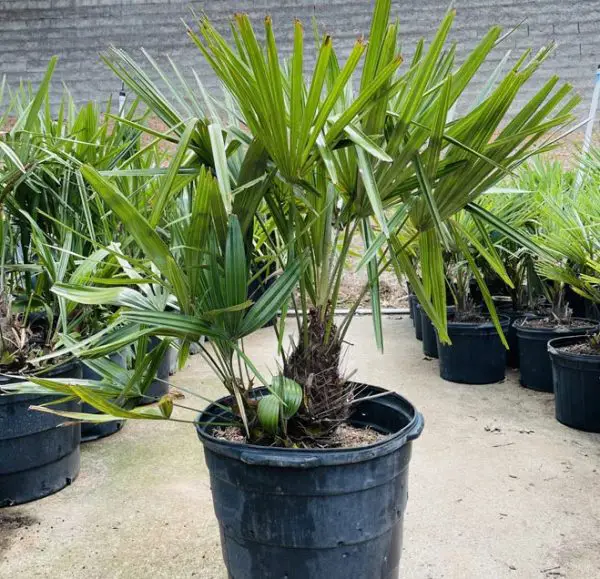
The Needle Palm (Rhapidophyllum hystrix) is a slow-growing perennial shrub with a hidden base under fiber husks and sharp needle-like spines, protecting it in winter. Native to the Southeastern U.S., it thrives in USDA zones 5b-11. Preferring full sun, it grows in fertile, well-drained soil with average water needs. Suitable for pots, it serves as a natural dehumidifier and air purifier, tolerating drought and wet soil, and surviving temperatures as low as -20°C.
Dwarf Palmetto Palm
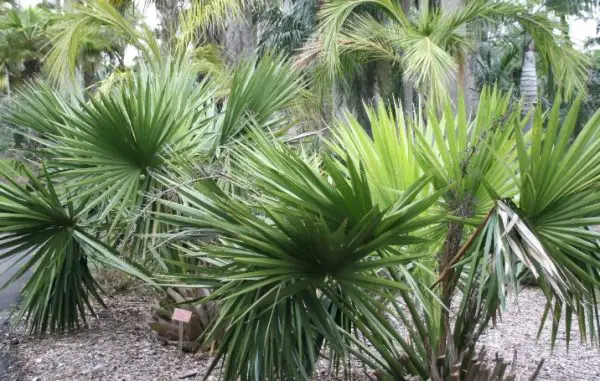
The Dwarf Palmetto Palm (Sabal minor) is a small, fan-shaped shrub with dark green segmented leaves and fragrant white flowers in spring, yielding dark brown fruit. Native to the Southern U.S., it thrives in USDA zones 8-11. Preferring partial shade and fertile, well-drained soil, it needs moist soil when young. Suitable for pots, it grows slowly to about 3 feet. Known for drought and salt tolerance, its extracts are used in herbal medicine.
Lady Palm
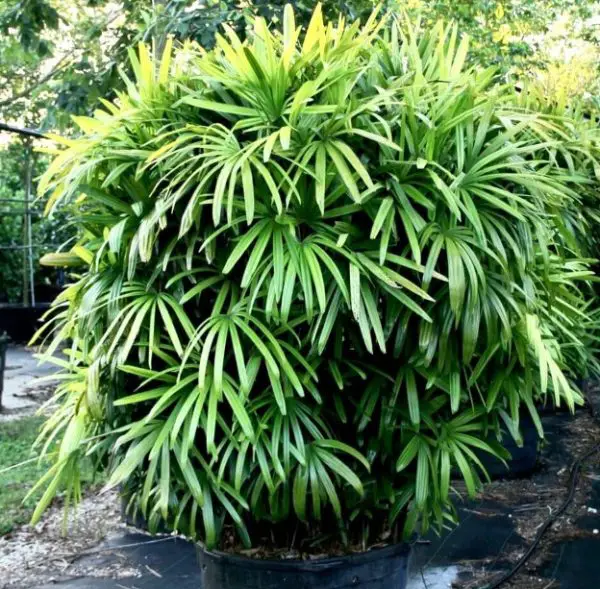
The Lady Palm (Rhapis excelsa), or miniature fan palm, has dark green, fan-shaped leaves divided into broad segments resembling fingers. With slender stems and a base covered in brown fibers, it’s native to China and thrives in USDA zones 9-11. Preferring partial to full shade, it grows in loamy, well-drained soil. Suitable for pots, it grows about 1 foot per year. This plant purifies air and tolerates low-light conditions, making it ideal for indoors.
Bismarck Palm
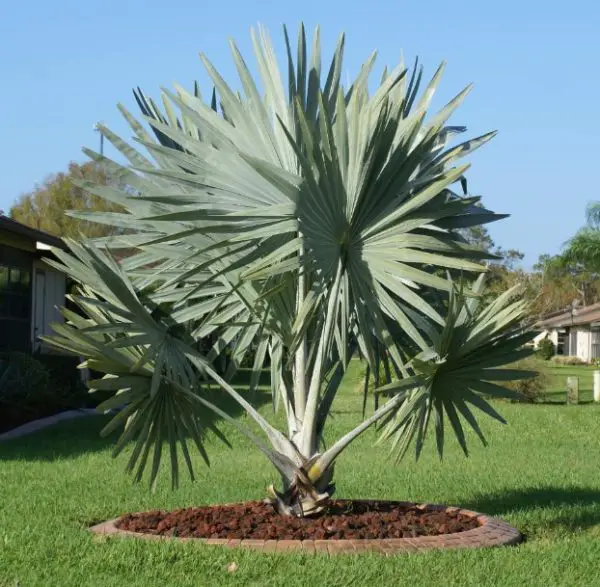
The Bismarck Palm (Bismarckia nobilis) is a glamorous landscape tree, reaching up to 60 feet tall and 15-20 feet wide. It features a strong, patterned trunk and a symmetrical crown of silver-green or olive-green fan-shaped leaves. Native to Madagascar and thriving in USDA zones 10-11, it prefers full sun and well-drained soil. While not suited for long-term potting, it adds stunning beauty to landscapes and grows about 2 feet annually.
Chinese Fan Palm
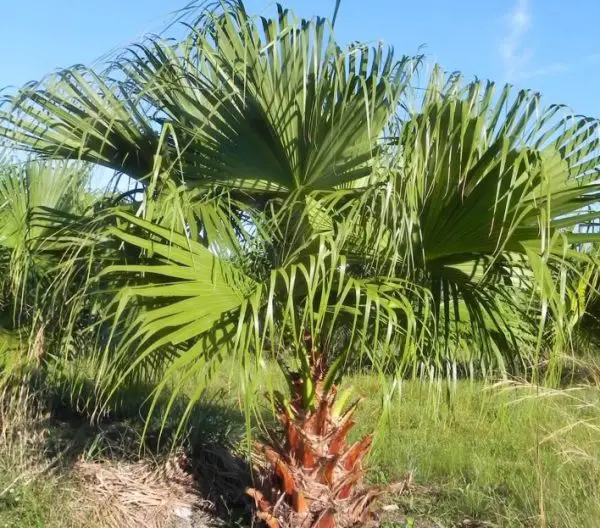
The Chinese Fan Palm (Livistona chinensis), also known as the fountain palm, has a strong trunk and a beautiful crown of light to dark green fan-shaped leaves. Native to Asia, it thrives in USDA zones 9-11 with full to partial sun and well-drained, sandy, loamy soil.
Suitable for large pots, it grows 7-8 inches per year and lives up to 40 years. This drought-tolerant palm’s extract is used in alternative medicine.
Coconut Palm
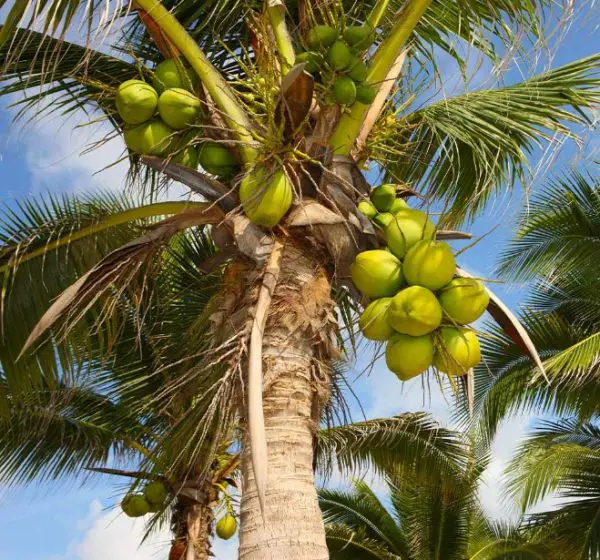
The Coconut Palm (Cocos nucifera) epitomizes palm trees with its long, curved trunk and large, segmented leaves, bearing bright coconuts. Thriving in warm, humid, tropical regions (USDA zones 10-12), it prefers full sun and fertile, well-drained soil. Regular watering keeps the soil moist, not soggy.
While it can be potted in a 10-gallon pot initially, repotting is needed as it grows. This palm can live up to 100 years and yield up to 180 coconuts.
Ponytail Palm
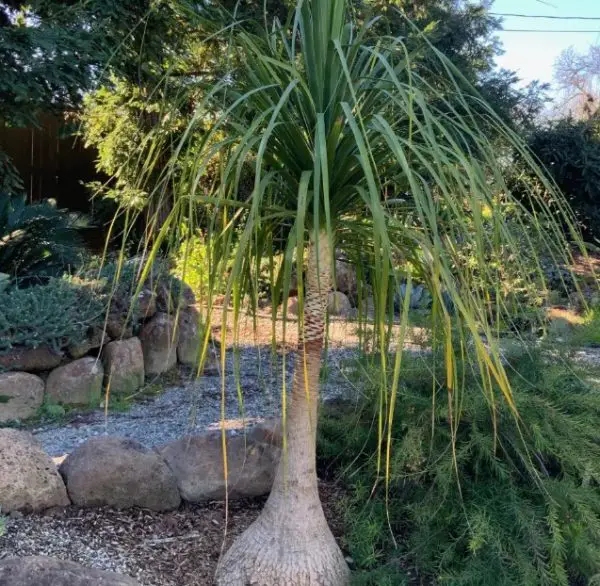
The Ponytail Palm (Beaucarnea recurvata) features a dome-shaped base that tapers upward, with green leaves cascading like ponytails. Native to southeastern Mexico and Belize, it thrives in USDA zone 9, preferring full sun and fertile, well-drained soil.
Water when the top 2-3 inches of soil are dry. Suitable for potting, choose a pot just 2-3 inches wider than the base. This air-purifying plant can live up to 100 years and tolerates short periods at 15°F.






